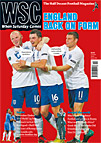 Steve Bradley explains why the opening night of a new national stadium led to unnecessary embarrassment
Steve Bradley explains why the opening night of a new national stadium led to unnecessary embarrassment
Wednesday August 4 should have been a proud day for Irish football. With the covers lifted from Lansdowne Road to reveal the new 50,000-capacity Aviva Stadium, the Football Association of Ireland (FAI) threw a housewarming party to celebrate. But the invite list and guests’ behaviour left a sour taste for some fans.
While the Irish public support their national team, most follow club sides in England and Scotland. For a minority, however, as for fans elsewhere, football is largely an expression of local pride and identity. And so they turn up week-in, week-out to watch the likes of Bohemians, Sligo Rovers and Cork City in the League of Ireland – local, modest clubs in a sport that is increasingly globalised and glamorous.
As the guardians of Irish football, the FAI have a duty to promote the game domestically. But poor financial planning has left them with a more pressing obligation. To finance their share of the Aviva Stadium they banked on the sale of 10,000 premium ten-year tickets. The price for these – from €12,000 (£10,000) to €32,000 – seemed bullish even pre-recession, but when the Celtic Tiger lurched into a coma sales evaporated. Half now remain unsold, leaving the FAI with a headache.
The first signs of the impact the financial squeeze would have on domestic clubs came in May, when the FAI refused Limerick permission to host a fundraising friendly against Barcelona. The episode was a PR disaster for the FAI, as it became clear that they intended to restrict any large glamour friendlies within their jurisdiction to the new stadium. The game would have been played 100 miles from Dublin and earned Limerick the majority of their season’s income. But with the FAI nervously eyeing their own balance sheet, even protests from Barça themselves had no effect.
So when it came to the line-up for the opening fixture at their new home, the FAI faced a conundrum. A big-draw foreign club was a given, but credibility also demanded that the game have an Irish angle. The obvious option would have been the Republic’s national team, but they were already scheduled to play there the following week. So the FAI opted for a representative side from the League of Ireland to provide the required emerald veneer in taking on Manchester United.
The fact that the league’s top clubs might be more concerned with representing their country in European action on the night the fixture was scheduled for was a mere inconvenience. The FAI reportedly even asked UEFA if they would be willing to shift a Champions League qualifier should Dublin-based Bohemians be drawn at home on the same night as the stadium’s opening.
And so a hastily assembled squad of largely part-timers who had never played together convened to challenge one of the world’s strongest clubs in their pre-season prime. With the league’s top club, Shamrock Rovers, on European duty, the Irish side wasn’t even at full strength. But that was irrelevant. Like the embarrassing relative you feel compelled to invite to family weddings, no one wanted them there anyway.
Had this been a Hollywood script, the plucky underdogs would have been spurred on by a partisan crowd to claim a shock victory over their dandy counterparts. Instead, the Irish were pummelled 7-1, as a stadium full of their fellow countryfolk lapped it up. It was an uncomfortable freakshow experience for fans of the domestic game. The league they love had been humiliated so their administrators could continue the down payments on a new home.
So what were the FAI’s alternatives? No combination of League of Ireland clubs alone would have guaranteed a full house, and it would serve no one in Irish football if their governing body hit financial problems. Most league followers understand this, if only begrudgingly. For many, therefore, the real source of disgruntlement was the choice of teams – the FAI invited their league’s biggest competitor into their new home, giving Manchester United licence to humiliate Irish football in front of its own public. So 50,000 Irish people cheered on an English club against a team with Ireland written on their shirts – another generation lost to the domestic game.
It’s hard to fathom why the FAI thought this predictably one-sided affair would do anything for the standing of the league. But, with financial pressures mounting, such considerations may seem to be an inconvenient luxury. Irish football does indeed have a new residence. But for many of those who follow the game week in, week out across the country, it has so far been made to feel anything but a home.
From WSC 284 November 2010